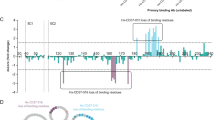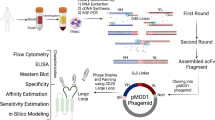Abstract
Variable antigen-binding domain of camelid single chain antibodies (VHH, Nanobody) and its conjugates are considered among very promising candidates in tumor diagnosis and treatment because of its small size, stability, and favorable bio-distribution. CD22 is a receptor that is expressed on most B cells and modulates their function. Targeting CD22 in B cell malignancies and disorders by monoclonal antibodies has shown promising results in vitro and in clinical trials. In this study, we investigate the impact of an anti-human CD22 VHH binding to CD22 on B cells and its internalization following attachment. Our findings demonstrate the proliferation inhibiting of these cells with no effect on apoptosis, in addition to the rapid internalization of the VHH.



Similar content being viewed by others
References
Arndt MA, Krauss J, Schwarzenbacher R, Vu BK, Greene S, Rybak SM (2003) Generation of a highly stable, internalizing anti-CD22 single-chain Fv fragment for targeting non-Hodgkin’s lymphoma. Int J Cancer 107:822–829
Behdani M, Zeinali S, Karimipour M, Khanahmad H, Schoonooghe S, Aslemarz A, Seyed N, Moazami-Godarzi R, Baniahmad F, Habibi-Anbouhi M (2013) Development of VEGFR2-specific Nanobody Pseudomonas exotoxin A conjugated to provide efficient inhibition of tumor cell growth. New Biotechnol 30:205–209
Carnahan J, Wang P, Kendall R, Chen C, Hu S, Boone T, Juan T, Talvenheimo J, Montestruque S, Sun J (2003) Epratuzumab, a humanized monoclonal antibody targeting CD22: characterization of in vitro properties. Clin Cancer Res 9:3982s–3990s
Carnahan J, Stein R, Qu Z, Hess K, Cesano A, Hansen HJ, Goldenberg DM (2007) Epratuzumab, a CD22-targeting recombinant humanized antibody with a different mode of action from rituximab. Mol Immunol 44:1331–1341
Chakravarty R, Goel S, Cai W (2014) Nanobody: the “magic bullet” for molecular imaging. Theranostics 4:386–398
Chaouchi N, Vazquez A, Galanaud P, Leprince C (1995) B cell antigen receptor-mediated apoptosis. Importance of accessory molecules CD19 and CD22, and of surface IgM cross-linking. J Immunol 154:3096–3104
Cyster JG, Goodnow CC (1997) Tuning antigen receptor signaling by CD22: integrating cues from antigens and the microenvironment. Immunity 6:509–517
Daridon C, Blassfeld D, Reiter K, Mei HE, Giesecke C, Goldenberg DM, Hansen A, Hostmann A, Frölich D, Dörner T (2010) Epratuzumab targeting of CD22 affects adhesion molecule expression and migration of B-cells in systemic lupus erythematosus. Arthr Res Ther 12:R204
Doody GM, Justement LB, Delibrias CC, Matthews RJ, Lin J, Thomas ML, Fearon DT (1995) A role in B cell activation for CD22 and the protein tyrosine phosphatase SHP. Science 269:242–244
Dörner T, Shock A, Goldenberg DM, Lipsky PE (2015) The mechanistic impact of CD22 engagement with epratuzumab on B cell function: implications for the treatment of systemic lupus erythematosus. Autoimmun Rev 14:1079–1086
Du X, Beers R, Fitzgerald DJ, Pastan I (2008) Differential cellular internalization of anti-CD19 and-CD22 immunotoxins results in different cytotoxic activity. Cancer Res 68:6300–6305
Fan X, Hu Y, Huang H (2014) Nanobodies: novel biomedical vehicles in targeting tumor. J Chem Pharm Res 6:458–460
Faraji F, Tajik N, Behdani M, Shokrgozar MA, Zarnani AH, Shahhosseini F, Habibi-Anbouhi M (2018) Development and characterization of a camelid single domain antibody directed to human CD22 biomarker. Biotechnol Appl Biochem 65:718–725
Fernandes JC (2018) Therapeutic application of antibody fragments in autoimmune diseases: current state and prospects. Drug Discov Today. https://doi.org/10.1016/j.drudis.2018.06.003
Gudowius S, Recker K, Laws H-J, Dirksen U, Tröger A, Wieczorek U, Furlan S, Göbel U, Hanenberg H (2006) Identification of candidate target antigens for antibody-based immunotherapy in childhood B-cell precursor ALL. Klinische Pädiatrie 218:327–333
Heukers R, Altintas I, Raghoenath S, de Zan E, Pepermans R, Roovers RC, Haselberg R, Hennink WE, Schiffelers RM, Kok RJ (2014) Targeting hepatocyte growth factor receptor (Met) positive tumor cells using internalizing nanobody-decorated albumin nanoparticles. Biomaterials 35:601–610
Homayouni V, Ganjalikhani-Hakemi M, Rezaei A, Khanahmad H, Behdani M, Lomedasht FK (2016) Preparation and characterization of a novel nanobody against T-cell immunoglobulin and mucin-3 (TIM-3). Iran J Basic Med Sci 19:1201
Jacobi AM, Goldenberg DM, Hiepe F, Radbruch A, Burmester GR, Dörner T (2008) Differential effects of epratuzumab on peripheral blood B cells of patients with systemic lupus erythematosus versus normal controls. Ann Rheum Dis 67:450–457
John B, Herrin BR, Raman C, Wang Y-N, Bobbitt KR, Brody BA, Justement LB (2003) The B cell coreceptor CD22 associates with AP50, a clathrin-coated pit adapter protein, via tyrosine-dependent interaction. J Immunol 170:3534–3543
Keyaerts M, Xavier C, Heemskerk J, Devoogdt N, Everaert H, Ackaert C, Vanhoeij M, Duhoux FP, Gevaert T, Simon P (2016) Phase I study of 68 Ga-HER2-nanobody for PET/CT assessment of HER2 expression in breast carcinoma. J Nucl Med 57:27–33
Kijanka M, Dorresteijn B, Oliveira S, van Bergen en Henegouwen PM (2015) Nanobody-based cancer therapy of solid tumors. Nanomedicine 10:161–174
Lamb YN (2017) Inotuzumab ozogamicin: first global approval. Drugs 77:1603–1610
Leonard JP, Coleman M, Ketas JC, Chadburn A, Furman R, Schuster MW, Feldman EJ, Ashe M, Schuster SJ, Wegener WA (2004) Epratuzumab, a humanized anti-CD22 antibody, in aggressive non-Hodgkin’s lymphoma. Clin Cancer Res 10:5327–5334
Mason D, Stein H, Gerdes J, Pulford K, Ralfkiaer E, Falini B, Erber W, Micklem K, Gatter K (1987) Value of monoclonal anti-CD22 (p135) antibodies for the detection of normal and neoplastic B lymphoid cells. Blood 69:836–840
Muyldermans S (2013) Nanobodies: natural single-domain antibodies. Annu Rev Biochem 82:775–797
Oliveira S, Heukers R, Sornkom J, Kok RJ, En Henegouwen PMVB (2013) Targeting tumors with nanobodies for cancer imaging and therapy. J Control Release 172:607–617
Parish CR, Glidden MH, Quah BJ, Warren HS (2009) Use of the intracellular fluorescent dye CFSE to monitor lymphocyte migration and proliferation. Curr Protoc Immunol 84:4–9
Pezzutto A, Dörken B, Moldenhauer G, Clark EA (1987) Amplification of human B cell activation by a monoclonal antibody to the B cell-specific antigen CD22, Bp 130/140. J Immunol 138:98–103
Pezzutto A, Rabinovitch PS, Dörken B, Moldenhauer G, Clark EA (1988) Role of the CD22 human B cell antigen in B cell triggering by anti-immunoglobulin. J Immunol 140:1791–1795
Rezaei G, Habibi-Anbouhi M, Mahmoudi M, Azadmanesh K, Moradi-Kalbolandi S, Behdani M, Ghazizadeh L, Abolhassani M, Shokrgozar MA (2017) Development of anti-CD47 single-chain variable fragment targeted magnetic nanoparticles for treatment of human bladder cancer. Nanomedicine 12:597–613
Ries J, Kaplan C, Platonova E, Eghlidi H, Ewers H (2012) A simple, versatile method for GFP-based super-resolution microscopy via nanobodies. Nat Methods 9:582–584
Shan D, Ledbetter JA, Press OW (1998) Apoptosis of malignant human B cells by ligation of CD20 with monoclonal antibodies. Blood 91:1644–1652
Sieber T, Schoeler D, Ringel F, Pascu M, Schriever F (2003) Selective internalization of monoclonal antibodies by B-cell chronic lymphocytic leukaemia cells. Br J Haematol 121:458–461
Sullivan-Chang L, O’donnell RT, Tuscano JM (2013) Targeting CD22 in B-cell malignancies: current status and clinical outlook. BioDrugs 27:293–304
Tateno H, Li H, Schur MJ, Bovin N, Crocker PR, Wakarchuk WW, Paulson JC (2007) Distinct endocytic mechanisms of CD22 (Siglec-2) and Siglec-F reflect roles in cell signaling and innate immunity. Mol Cell Biol 27:5699–5710
Terstappen L, Johnsen S, Segers-Nolten I, Loken MR (1990) Identification and characterization of plasma cells in normal human bone marrow by high-resolution flow cytometry. Blood 76:1739–1747
Tuscano JM, Riva A, Toscano SN, Tedder TF, Kehrl JH (1999) CD22 cross-linking generates B-cell antigen receptor-independent signals that activate the JNK/SAPK signaling cascade. Blood 94:1382–1392
Van Audenhove I, Gettemans J (2016) Nanobodies as versatile tools to understand, diagnose, visualize and treat cancer. EBioMedicine 8:40–48
Funding
This study was supported financially by Iran University of medical sciences as a Ph.D. thesis.
Author information
Authors and Affiliations
Corresponding authors
Ethics declarations
Conflict of interest
The authors have no other relevant affiliations or financial involvement with any organization or entity with a financial interest in or financial conflict with the subject matter or materials discussed in the manuscript apart from those disclosed.
Additional information
Publisher's Note
Springer Nature remains neutral with regard to jurisdictional claims in published maps and institutional affiliations.
Rights and permissions
About this article
Cite this article
Faraji, F., Habibi-Anbouhi, M., Behdani, M. et al. Functional Study of a Camelid Single Domain Anti-CD22 Antibody. Int J Pept Res Ther 26, 633–639 (2020). https://doi.org/10.1007/s10989-019-09870-y
Accepted:
Published:
Issue Date:
DOI: https://doi.org/10.1007/s10989-019-09870-y




